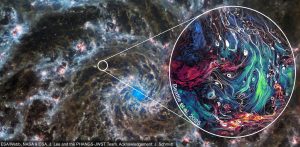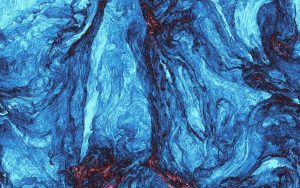CITA Fellow James Beattie and his team use supercomputer simulations to challenge classical understanding of magnetic turbulence
Astronomers have developed a computer simulation to explore, in unprecedented detail, magnetism and turbulence in the interstellar medium (ISM)—the vast ocean of gas and charged particles that lies between stars in the Milky Way galaxy.

Caption: A composite image of the Phantom Galaxy and (inset) a high-resolution simulation of galactic turbulence with magnetic field lines in white. Credit: ESA/Webb, NASA & CSA, J. Lee and the PHANGS-JWST Team; Acknowledgement: J. Schmidt; Simulation: J. Beattie.
Turbulence is a ubiquitous phenomenon, which all of us have witnessed. The swirly movement of mixing milk in a coffee cup is the same in principle as the chaotic flows in the oceans, solar wind, interstellar medium (ISM) and plasma between galaxies. The key distinction in astrophysical environments is the presence of magnetic fields, which fundamentally alter the nature of turbulent flows. Magnetised turbulence, which is hard to capture through mathematical equations and computer models, is also believed to be a decisive factor in the distribution of particles in the universe, the density variations in gasses, ISM, and star formation.
Using extremely high-resolution simulations of magnetized turbulence, CITA and Princeton Fellow James Beattie and his team show that the turbulent dynamics typical of the interstellar medium (ISM) significantly deviate from widely used classical models. The groundbreaking computer simulation the scholars have developed is described in a new study published today in Nature Astronomy, the model is the most powerful to date, requiring the computing capability of the SuperMUC-NG supercomputer at the Leibniz Supercomputing Centre in Germany. It directly challenges our understanding of how magnetized turbulence operates in astrophysical environments.
James Beattie, the paper’s lead author, is hopeful the model will provide new insights into the ISM, the magnetism of the Milky Way Galaxy as whole, and astrophysical phenomenon such as star formation and the propagation of cosmic rays.
“This is the first time we can study these phenomena at this level of precision and at these different scales,” Beattie says.
The paper was co-authored with researchers from Princeton University; Australian National University; the Australian Research Council Center of Excellence in All Sky Astrophysics; Universität Heidelberg; the Center for Astrophysics, Harvard & Smithsonian; Harvard University; and the Bavarian Academy of Sciences and Humanities.

Caption: Fractal density structures in the world’s largest turbulence simulation, with high-densities shown in red, and low-densities shown in blue. Credit: Simulation: J. Beattie.
Read more on A&S News, Phys.org, Biongineer.org, Eurekalert.org.
Contact:
Lyuba Encheva
Communications and Events, CITA
Email: lyuba@cita.utoronto.ca